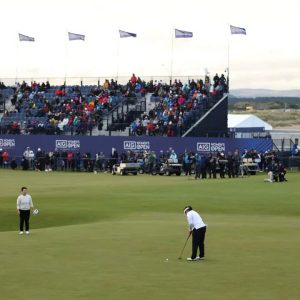A homeowner wonders why his grass won’t grow. A superintendent has ideas
A frustrated man mowing a lawn
On a tree-shaded site in Rochester, N.Y., a homeowner can’t get grass to grow. But a golf course superintendent has some tips.
Getty Images
Superintendents — they’re just like us! At least, they’re not so different that we can’t ask them for advice. In this column, we welcome readers’ yard-care questions, which we pass on to turf-care experts in the golf industry.


The following query comes from Daniel Marr, in Rochester, N.Y.
“We have a strip of grass in front of our home between the sidewalk and the street where an old maple tree stands. The last two springs, I have removed three inches of soil 10-feet in length, screened the soil, put down Scotts PatchMaster and watered. I have had success with grass coming in nicely. Then the heat comes and the maple seems to take everything out of the ground in that 10-foot swatch and thins the grass out. We use slow-release nitrogen fertilizer four times a year on our lawn and the median. Anything we should do differently to maintain the grass year-round?
An old maple tree on a median in Rochester, NY.
An old maple has made life tough on the grass beneath it. Courtesy Daniel Marr
Dear Daniel:
Location, location, location. What matters in real estate is important in turf care, too. And that median qualifies as a challenging site, according to Kevin Doyle, a field staffer in the Northeast region for the Golf Course Superintendents Association of America.
For starters, Doyle says, cities like Rochester use salt on roads during inclement weather, and no cool-season grass will tolerate high-sodium soil. As a consequence, “turf failure close to roadways should be expected,” Doyle says. It might help somewhat to dig up and sift the soil so that the higher concentrations of sodium at the top get distributed more evenly. As you water the grass seed, that will also dilute things. But you’re not going to rid the soil of all that sodium. The scenario, Doyle says, is “typical here in the Northeast.”
Then there’s the matter of the maple. Beautiful, tree, no doubt. But, as you clearly understand from your question, trees and grass are often at odds. They compete for sunlight, water and other nutrients. In some cases, trimming tree limbs can be helpful, as it allows more sunlight through. But, Doyle says, that depends on the location of the tree in reference to the compass. “If the tree is east-west of the turf, some pruning might help increase the turf’s access to sunlight,” Doyle says. If it’s to the north, however, blocked sunlight isn’t an issue and trimming wouldn’t make a difference. If the tree is to the south, “it would impede the most sunlight,” Doyle says, and removing the tree would be the best option. Actually, Doyle says, if growing grass is your top priority, removing the tree is the best way to go, period. Whether you’d be allowed to is another matter. City regulations may prevent you from touching the tree at all.
Lastly, there’s the matter of grass varietal. Your current choice, Doyle says, “is not ideal.” Given the shade issues created by the tree, you want turf that tolerates low light. And Bluegrass, which is included in the mixture you’ve put down, “is destined for failure.” Fescue is much better at tolerating shade. What’s more, Doyle says, the deeper roots it develops will help it survive better as it competes for water with the tree.
So there you have it, Daniel. Sounds like you’ve got your work cut out for you. But, like golf, if it weren’t a challenge, it wouldn’t be fun, right?





